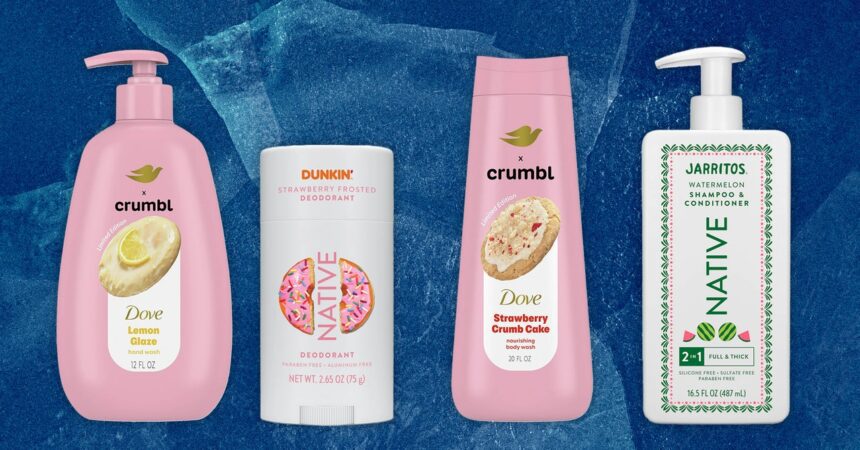The Rise of Edible Beauty: How Food and Cosmetics Are Melding Together
Introduction
In recent years, the beauty industry has embraced a trend that extends beyond mere food-inspired aesthetics. The emergence of products like cinnamon cookie butter hair, blueberry milk nails, and even glazed doughnut skin signifies a bold move toward brands that unashamedly want to imitate food. In 2023, this trend has not only captured the imagination of millennials and Gen Z but also reshaped the entire landscape of cosmetics and personal care.
The Fusion of Food and Beauty
This peculiar trend, described aptly as “edible beauty,” sees everyday cosmetics making radical moves to evoke sensory nostalgia for youth. Imagine having hair that smells like freshly baked cinnamon cookies or nails that resemble blueberry milkshake—these products are not just about their delightful appearances but also their scent and the emotions they invoke.
Millennial and Gen Z Appeal
For millennials and zillennials, these quirky offerings evoke memories of candy-scented products from their childhoods, creating a sense of nostalgia that is hard to resist. For Gen Z, it’s a juxtaposition of "high and low" culture, where a luxe beauty brand might collaborate with a fast-food giant, like Dunkin’. This blend of familiar comfort foods with beauty products provides an avenue for self-expression while reveling in irony—a playful take on modern consumer culture.
TikTok: The Catalyst
TikTok is pivotal in this edible beauty revolution. The platform’s algorithm thrives on absurd content, amplifying the reach of these bizarre beauty launches. Marketers are embracing strategies reminiscent of streetwear brands, introducing limited-edition products designed to cultivate urgency and exclusivity. These ephemeral offerings generate a fervor among FOMO (Fear of Missing Out)-prone shoppers, driving social media chatter and viral trends.
The Business of Edible Beauty
The collaboration between beauty brands and food franchises is lucrative. According to Licensing International’s 2023 Global Licensing Industry Study, the food and beverage (F&B) licensing sector grew by 5.3%. This figure suggests that the cosmetic industry is keen to dip into this fertile market, reaping benefits from relationships that capitalize on the resonance of #BeautyTok.
Through clever marketing and partnerships, food brands can leverage the expansive reach of social media to tap into new demographics. The resulting concoction boosts both sales and visibility, spreading brand recognition in an increasingly competitive landscape.
The Balance of Novelty and Sustainability
Despite the excitement surrounding edible beauty, the question arises: how sustainable is this trend? The novelty of products that are essentially jokes can wear thin, creating a risk for brands. The enchantment of spritzing on Crunchwrap-scented cologne or applying Hot Cheetos-flavored toothpaste may eventually crumble as consumers tire of gimmicks.
Moreover, meaningful innovations in the beauty sector must evolve alongside these whimsical products. If brands solely focus on absurdity without substance, they might find themselves in a precarious position. After all, when the novelty fades, consumers must still see value and authenticity in the products they choose.
The Consumer’s Perspective: A Cautionary Tale
As this trend burgeons, a cautionary tone emerges. The punchline of culinary beauty may ultimately be not about the products themselves but the consumer experience—who wants to wake up smelling like Cheetos or pickles? The danger lies in crossing into kitsch territory where the humor detracts from genuine enjoyment.
Conclusion: Where Do We Go From Here?
The edible beauty phenomenon invites curiosity about what will come next. Could we see the launch of a McRib collagen serum or a fast-food-themed skincare line? While these ideas initially elicit laughter and intrigue, we must reflect on their long-term viability.
As consumers, we should be mindful of the choices we make amid trends that prioritize novelty over substance. As the market evolves, it will be fascinating to observe whether brands find a balance that satisfies both the appetite for whimsy and the demand for authenticity. In the ever-changing landscape of beauty, one thing remains clear: the future is surprisingly edible.
This blog post encapsulates the rapidly evolving edible beauty trend, emphasizing its appeal, economic implications, pitfalls, and potential future. The intersection of nostalgia, irony, and hyper-consumerism offers a rich vein for exploration in contemporary culture.










